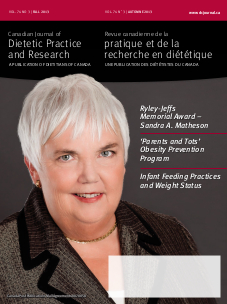Abstract
Purpose: Feeding practices for young Canadian children from economically disadvantaged neighbourhoods were examined to determine adherence to infant feeding recommendations and factors associated with children’s weight status.
Methods: Data for the study were collected from 1996 to 2003 as part of Better Beginnings, Better Futures, a longitudinal primary prevention initiative in Ontario. Study subjects were 546 children at age three months and 483 children at age 48 months.
Results: Mothers who had less than a high school education (odds ratio [OR] = 1.83, confidence interval [CI] = 1.01-3.29) and mothers who did not attend prenatal classes (OR=2.37, CI=1.33-4.24) were more likely to use formula. Mothers who were single parents were three times more likely to have an obese child (OR=3.35, CI=1.39-8.06) than were mothers who were married or with a partner.
Conclusions: Targeted strategies are needed for families as single-parent households were predictive of obesity in young children. Innovative encouragement to participate in prenatal programming for pregnant women who have less than a high school education may improve breastfeeding rates.
Résumé
Objectif: Les pratiques d’alimentation des jeunes enfants canadiens issus de quartiers défavorisés ont été examinées afin de déterminer l’adhésion aux recommandations sur l’alimentation des nourrissons et les facteurs associés au statut pondéral des enfants.
Méthodes: Les données employées pour l’étude ont été recueillies de 1996 à 2003 dans le cadre de Partir d’un bon pas pour un avenir meilleur, une initiative de prévention primaire longitudinale mise en place en Ontario. Les sujets de l’étude étaient 546 enfants âgés de trois mois et 483 enfants âgés de 48 mois.
Résultats: Les mères qui n’avaient pas terminé des études secondaires (rapport de cotes [RC] = 1,83; intervalle de confiance [IC] = 1,01-3,29) et celles qui n’avaient pas suivi de cours prénatals (RC = 2,37; IC = 1,33-4,24) étaient plus susceptibles d’avoir recours à la préparation pour nourrissons. De plus, les mères monoparentales étaient trois fois plus susceptibles d’avoir un enfant obèse (RC = 3,35; IC = 1,39-8,06) par rapport aux mères mariées ou en couple.
Conclusions: Des stratégies ciblées à l’intention des familles doivent être mises en place, puisque les ménages monoparentaux sont un facteur prédicteur de l’obésité chez les jeunes enfants. Par ailleurs, des initiatives novatrices encourageant les femmes enceintes n’ayant pas terminé leurs études secondaires à prendre part aux programmes prénatals pourraient améliorer les taux d’allaitement.



